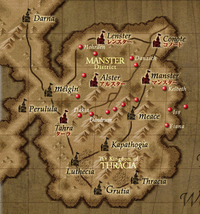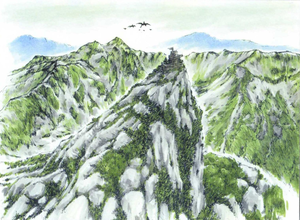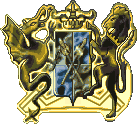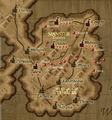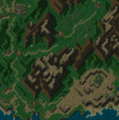| Site News |
|---|
| Warning: This wiki contains spoilers. Read at your own risk! Social media: If you would like, please join our Discord server, and/or follow us on X (Twitter) or Tumblr! |
Thracia
| ||||||
|
| “ | The Thracian Peninsula has two very distinct faces. [...] The south, however, is a barren wasteland lined with towering mountains, and home to the Thracia Kingdom and their infamous Dragon Knights. With reckless valor, Thracia made repeated attempts to conquer the northern fertile land. | ” | — Opening of Chapter 8 |
|---|
Thracia (pronounced /ˈθɹeɪʃə/[key][1]; Japanese: トラキア Thracia) is a nation occupying the southern half of the Thracian Peninsula of Jugdral, situated to the south of the Munster District and connected to Miletos by a thin strip of land to the north-west. It was originally jointly founded by siblings Dáinn and Njörun of the Twelve Crusaders following the downfall of the Loptrian Empire, but a schism early in its history caused it to split into the two rival territories; its royal family is of Dáinn's lineage, and thus are the inheritors of his holy weapon, the Heavenly Lance Gungnir. The vast majority of Thracia's land is dominated by mountains and thus very little is arable and suited for farming, and so the nation has historically survived through hiring out its famed Wyvern Riders as mercenaries.
History
Originally a single nation encompassing the entire Thracian Peninsula, Thracia was jointly founded by the Crusaders Dáinn and Njörun, with Dáinn as its king after the downfall of the Loptrian Empire in Grann 648, and for a time the nation experienced peace. However, the nation was stricken by turmoil in Grann 658, ten years after foundation, after a series of tragedies starting with the Tragedy of the Gáe Bolg, in which Njörun inadvertently killed her own husband while trying to prevent him and Dáinn from fighting, followed by Njörun's suicide and Dáinn's own mysterious demise[2]. This tragedy left rule of Thracia in the hands of Dáinn's son, a cruel and ill-tempered man who terrorized and suppressed the nation's people. In response, Njörun's son led a coalition of Thracian dukes in revolt against Dáinn's son, claiming the northern half of the peninsula as their own individual nations; with Grannvale's mediatory intervention and the eventual assent of Dáinn's son, the territory formally seceded from Thracia and became the independent Munster District, a collective of kingdoms led by the kingdom founded by Njörun's son, Leonster[3].
For much of its subsequent history, Thracia vied to reclaim the northern half of the peninsula as its own, as it was severely crippled by its lack of access to the lush vegetation of the north; the Thracian territory possesses very little arable land of its own. Its primary means of survival was to hire its famous Dragon Knights out as mercenaries, funding its own survival by this meager pay. However, with Leonster's elite Lanceritter knight legion, Thracia was never able to make any significant progress in fighting the Munster District, and so the two nations remained in a stalemate for over a century. Thracia's fortunes at first appeared to turn in Grann 761, when the reigning King Travant brutally killed Leonster's Prince Quan and the Lanceritter in an ambush which came to be known as the Aed Massacre, and subsequently assisted in the downfall of the Munster District in cooperation with Raydrik of Connacht; however, this was short-lived as Raydrik in turn betrayed Travant to the newly-minted Grannvale Empire, which subdued the Thracian army, claimed the Munster District as its own under Bloom of Friege, and cowed Travant into an unwilling and unequal alliance with Grannvale.
Thracia remained a servant state to Grannvale until Grann 777, in which Seliph Baldos Chalphy led his revolution army against Grannvale through the Munster District, liberating it and uniting with his cousin Leif, orphaned prince of Leonster. With the Grannvale occupation defeated, Travant sought to take the opportunity to strike at Seliph's tired army and reclaim the Munster District for himself, but instead entered a protracted battle with Seliph as he sought to invade and subdue Thracia; during this time, Leif was reunited with Altena, his elder sister who had been taken by Travant following his murder of her parents and raised as his own daughter. The conflict ended with Thracia in Seliph's control and Travant dead; however, his son Arion survived the battle, taken away by Grannvale's Prince Julius to ensure his survival. Under Arion, Thracia initially remained opposed to Seliph after he withdrew from the nation to march on Miletos and Grannvale; however, Altena convinced Arion to stand down and ally with Seliph instead. Following Seliph's victory against Julius at Belhalla, Thracia and the Munster District were reunited into a single nation by Leif, Altena and Arion, forming the New Kingdom of Thracia with Leif as its king.
Notable locations in Thracia
Thracia Castle
Thracia Castle is the capital of Thracia, situated in its far south-east, and is the seat of power from which the royal family rules.
Meath Castle
Meath Castle is the northernmost castle of Thracia, located near its border with the Munster District. It served as the first line of defense against Seliph's pending invasion, under General Maykov, and subsequently served as Seliph's base in his foray into the rest of Thracia.
Kapathogia Castle
Kapathogia Castle is located roughly in Thracia's center. It was entrusted to General Hannibal during the battle against Seliph's army.
Luthecia Castle
Luthecia Castle is the eastermost castle of Thracia, near its border with Miletos and the Munster District. It was placed under the guard of Distler, a general and advisor to Travant, during Seliph's invasion.
Grutia Castle
Grutia Castle is the southernmost castle of Thracia, and the southernmost known settlement in the entirety of Jugdral. It was entrusted to Judah of the Loptr Church as the last line of defense against Seliph before he reached the capital.
Fiana
- Main article:
Fiana
Fiana is a small coastal village situated in Thracia's east. Formerly overrun by bandits, it was cleaned up by the mercenary Eyvel, who subsequently became the village's head and the leader of the Fiana Freeblades, a mercenary team dedicated to the defense of Fiana and its neighbors.
Iz
Iz is a coastal Thracian village, and the northern neighbor of Fiana. It was the site of Leif's first skirmish on his way to Munster to rescue Nanna and Mareeta, and was where he met the tactician August.
Mount Violdrake
Mount Violdrake (Japanese: 紫竜山 Purple Dragon Mountain) is a mountain located in the western reaches of Thracia, between Tarrah and Hannibal's mansion. It is the home of a band of bandits led by Dagdar, an ally of Eyvel of Fiana. The village nearby is under the protection of Dagdar's bandits.
Characters from Thracia
| Character | Description | Appears in |
|---|---|---|
| Dáinn | One of the Twelve Crusaders, and the co-founder of Thracia along with his sister Njörun. | None |
| Njörun | One of the Twelve Crusaders, and the co-founder of Thracia along with her brother Dáinn. | None |
Travant |
King of Thracia from before Grann 757 until his death in Grann 777. | Genealogy of the Holy War, Thracia 776, Awakening, Heroes |
Arion |
Travant's son and successor as King of Thracia. | Genealogy of the Holy War, Thracia 776, Heroes |
Altena |
Adoptive daughter of Travant; actually the princess of Leonster and daughter of Quan. | Genealogy of the Holy War, Thracia 776, Awakening, Heroes |
Hannibal |
A renowned Thracian general, dubbed "The Shield of Thracia". | Genealogy of the Holy War, Thracia 776 |
Eyvel |
The leader of Fiana and the Fiana Freeblades; formerly known as Brigid of Yngvi. | Thracia 776, Heroes |
Osian |
A member of the Fiana Freeblades. | Thracia 776, Heroes |
Halvan |
A member of the Fiana Freeblades. | Thracia 776 |
Dagdar |
The leader of a bandit group based in Mount Violdrake. An ally of Eyvel. | Thracia 776 |
Tanya |
Dagdar's daughter and one of his bandits. | Thracia 776, Heroes |
Marty |
One of Dagdar's bandits. | Thracia 776 |
Ronan |
A resident of Iz. | Thracia 776, Heroes |
Carrion |
A former Leonster knight, taken in by Hannibal. | Thracia 776 |
Deen |
A former Thracian knight, and Eda's older brother. | Thracia 776 |
Eda |
A knight of Thracia and Deen's younger sister. | Thracia 776 |
Leif |
Prince of Leonster and younger brother of Altena. The first king of the unified New Kingdom of Thracia. | Genealogy of the Holy War, Thracia 776, Awakening, Heroes, Engage |
Papilio |
A mercenary sent to assist Chagall in Agustria. | Genealogy of the Holy War |
Magorn |
A dracoknight who assists Travant in his ambush of Quan | Genealogy of the Holy War |
Coulter |
A knight of Thracia. | Genealogy of the Holy War, Thracia 776 |
Maykov |
A knight of Thracia charged with defending Meath castle. | Genealogy of the Holy War |
Kanatz |
A knight of Thracia charged with defending Kapathogia castle. | Genealogy of the Holy War |
Distler |
A general of Thracia and a confidante to Travant. | Genealogy of the Holy War |
Rumei |
A knight of Thracia, hired by Gomez. | Thracia 776 |
Merlock |
A knight of Thracia instructed to clear out bandits in Mount Violdrake. | Thracia 776 |
Dvorak |
A knight of Thracia helping the Grannvale Empire in Nowell Valley. | Thracia 776 |
McCloy |
A knight of Thracia who assisted in the seizing Tarrah. | Thracia 776 |
Genealogy
| Genealogy of the Kingdom of Thracia | |||||||||||||||||||||||||||||||||||||||||||||||||||||||||||||||||||||||||||||||||||||||||||||||||||||||||||||||||||||||||||||||||||||||||||||||||||||||||||||||||||||||||||||||||||||||||||||||||||||||||||||||||||||||||||||||||||||||||||||||||||||||||||||||||||||||||||||||||||||||||||||||||||||||||||||||||||||||||||||||||||||||||||||||||||||||||||||||||||||||||||||||||||||||||||||||||||||||||||||||||||||||||||||||||||||||||||||||||||||||||||||||||||||||||||||||||||||||||||
|---|---|---|---|---|---|---|---|---|---|---|---|---|---|---|---|---|---|---|---|---|---|---|---|---|---|---|---|---|---|---|---|---|---|---|---|---|---|---|---|---|---|---|---|---|---|---|---|---|---|---|---|---|---|---|---|---|---|---|---|---|---|---|---|---|---|---|---|---|---|---|---|---|---|---|---|---|---|---|---|---|---|---|---|---|---|---|---|---|---|---|---|---|---|---|---|---|---|---|---|---|---|---|---|---|---|---|---|---|---|---|---|---|---|---|---|---|---|---|---|---|---|---|---|---|---|---|---|---|---|---|---|---|---|---|---|---|---|---|---|---|---|---|---|---|---|---|---|---|---|---|---|---|---|---|---|---|---|---|---|---|---|---|---|---|---|---|---|---|---|---|---|---|---|---|---|---|---|---|---|---|---|---|---|---|---|---|---|---|---|---|---|---|---|---|---|---|---|---|---|---|---|---|---|---|---|---|---|---|---|---|---|---|---|---|---|---|---|---|---|---|---|---|---|---|---|---|---|---|---|---|---|---|---|---|---|---|---|---|---|---|---|---|---|---|---|---|---|---|---|---|---|---|---|---|---|---|---|---|---|---|---|---|---|---|---|---|---|---|---|---|---|---|---|---|---|---|---|---|---|---|---|---|---|---|---|---|---|---|---|---|---|---|---|---|---|---|---|---|---|---|---|---|---|---|---|---|---|---|---|---|---|---|---|---|---|---|---|---|---|---|---|---|---|---|---|---|---|---|---|---|---|---|---|---|---|---|---|---|---|---|---|---|---|---|---|---|---|---|---|---|---|---|---|---|---|---|---|---|---|---|---|---|---|---|---|---|---|---|---|---|---|---|---|---|---|---|---|---|---|---|---|---|---|---|---|---|---|---|---|---|---|---|---|---|---|---|---|---|---|---|---|---|---|---|---|---|---|---|---|---|---|---|---|---|---|---|---|---|---|---|---|---|---|---|---|---|---|---|---|---|---|---|---|---|---|---|---|---|---|---|---|---|---|---|---|---|---|---|---|---|---|---|---|---|---|---|---|---|---|---|---|---|---|---|---|---|---|---|---|---|---|---|---|---|---|
| |||||||||||||||||||||||||||||||||||||||||||||||||||||||||||||||||||||||||||||||||||||||||||||||||||||||||||||||||||||||||||||||||||||||||||||||||||||||||||||||||||||||||||||||||||||||||||||||||||||||||||||||||||||||||||||||||||||||||||||||||||||||||||||||||||||||||||||||||||||||||||||||||||||||||||||||||||||||||||||||||||||||||||||||||||||||||||||||||||||||||||||||||||||||||||||||||||||||||||||||||||||||||||||||||||||||||||||||||||||||||||||||||||||||||||||||||||||||||||
| An unbroken line indicates direct descent; a dashed line (╍) indicates descent across multiple undefined generations. A double line indicates marriage and/or had children together; italics indicates the spouse from outside the family. Important relatives not directly connected with the Thracia family are marked in gray. | |||||||||||||||||||||||||||||||||||||||||||||||||||||||||||||||||||||||||||||||||||||||||||||||||||||||||||||||||||||||||||||||||||||||||||||||||||||||||||||||||||||||||||||||||||||||||||||||||||||||||||||||||||||||||||||||||||||||||||||||||||||||||||||||||||||||||||||||||||||||||||||||||||||||||||||||||||||||||||||||||||||||||||||||||||||||||||||||||||||||||||||||||||||||||||||||||||||||||||||||||||||||||||||||||||||||||||||||||||||||||||||||||||||||||||||||||||||||||||
Gameplay
Thracia as a whole is the subject of Chapter 9 of Fire Emblem: Genealogy of the Holy War, with Chapter 8 also including a small portion of its territory. It is also the subject of parts of Fire Emblem: Thracia 776, in Chapters 1 through 3 and Chapters 7 through 10.
Trivia
- The emblem in Fire Emblem: Thracia 776's logo is a mixture of Thracia's and Leonster's coats of arms; it is possibly the coat of arms of Leif's unified Thracia.
Etymology and other languages
| Names, etymology, and in other regions | ||
|---|---|---|
| Language | Name | Definition, etymology, and notes |
| English |
Thracia |
One of the location options for the player's profile card in Fire Emblem Awakening. From Thracia, the name given to the province of the Roman Empire in the region of Thrace, whose territory today incorporates parts of Turkey, Bulgaria and Greece. |
| Japanese |
トラキア |
Officially romanized as Thracia; as above. |
| Spanish |
Thracia |
As above. |
| French |
Thracia |
As above. |
| German |
Thracia |
As above. |
| Italian |
Thracia |
As above. |
| Portuguese (Brazil) |
Thracia |
From Rei de Thracia "King of Thracia" in Heroes, the Portuguese translation of Travant: King of Thracia's epithet. |
| Korean |
트라키아 |
Thracia; Used in Fates and Echoes: Shadows of Valentia, among the choices for the player's country in their profile card. |
| Traditional Chinese |
色雷斯 |
Thrace; from 色雷斯王 "King of Thrace" in Heroes, the Chinese translation of Travant: King of Thracia's epithet. |
Gallery
Map of the Thracian Peninsula from Thracia 776.
Thracia, as depicted in Chapter 9 of Genealogy of the Holy War.
Artwork of Thracia from the Fire Emblem Trading Card Game.
The coat of arms of Thracia from the Fire Emblem Trading Card Game.
Artwork of Thracia from Thracia 776 Illustrated Works.
References
- ↑ JDRider02, A bunch of Fire Emblem Title Drops by the Fire Emblem Heroes guys, YouTube, Published: February 11, 2017, Retrieved: February 12, 2017
- ↑ "A: Njörun married a knight who was friends with her brother Dáinn and lived a happy life with him. One day, her husband and King Dáinn fought each other over some dispute. Njörun tried to stop the two fighting, but accidentally killed her beloved husband (the weapon that took his life was her lance). That was the beginning of events, Later, Njörun committed suicide and King Dáinn died a mysterious death. Afterwards, within the Leonster Royal Family the legend was passed on that 'the Earth Lance and Heaven Lance call to each other' and 'the Earth Lance is a lance that causes love and sorrow'." — Designers' notes from a Genealogy of the Holy War playing guide, translated by Serenes Forest, Retrieved: April 11, 2013
- ↑ "Afterwards, the one who would succeed the Thracian throne was Dáinn's son, but he wasn't the type of person who would make a good king. After ascending the throne, he implemented a terror policy, operated by his trusted subordinates, to suppress the masses. This resulted in Njörun's son leading the marquesses to rebel, and in the end they successfully subdued the northern, fertile lands. Later, by Grandbell's mediation, the small countries to the north pushed Leonster to become the leader of the alliance, and with Thracia's permission they officially obtained independence." — Designers' notes from a Genealogy of the Holy War playing guide, translated by Serenes Forest, Retrieved: April 11, 2013
| Fire Emblem: Thracia 776 | ||||||||||||||||||||
|---|---|---|---|---|---|---|---|---|---|---|---|---|---|---|---|---|---|---|---|---|
|
